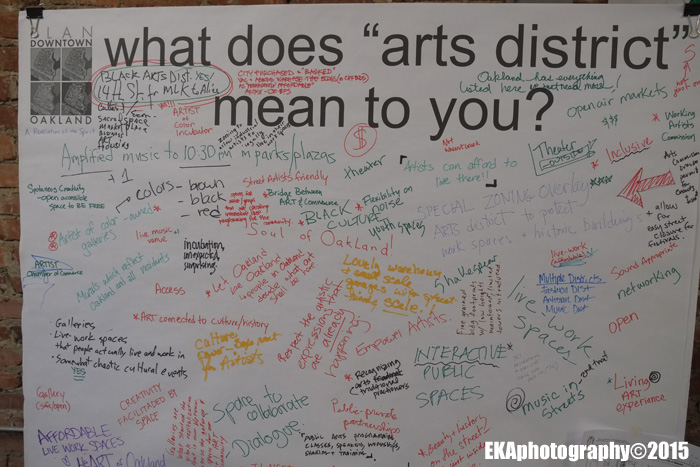
Power to the People: the Qilombo wall
In the wake of the recent completion of the mural dedicated to murdered painter Antonio Ramos and Soul of Oakland and OCNC rallies to defend Oakland’s culture, CRP painted the outside walls of community organization Qilombo as part of an anti-gentrification rally. Most of the massive wall, which features portraits of Assata Shakur,Thomas Sankara, and Amed Sekou Toure against a red black and green backdrop, was done in just one day.
Qilombo is currently facing another eviction attempt, this time from a company owned by Neill Sullivan, who has been one of the biggest purchasers of foreclosed homes in Oakland; according to the East Bay Express, Sullivan owns 270 parcels, most of which are in West Oakland.
The painting of the mural made an immediate visual and aesthetic difference in the neighborhood, a strip of San Pablo Avenue whose residents are primarily low-income people of color. There are several SRO hotels in the area, and blight, illegal dumping, and tag vandalism were common before the establishment of Qilombo and its community garden, Afrikatown.
Yet the neighborhood is also ground zero for encroaching gentrification; just a few blocks away, new luxury condos denote the boundaries of the tony, trendy Uptown district. According to blogger Bella Eiko, Sullivan plans to turn the space currently inhabited by Qilombo and Afrikatown into… a storage unit.
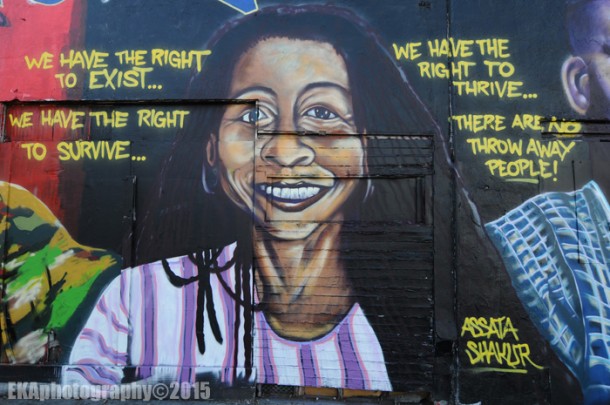
Portrait of Assata Shakur
While Qilombo/Afrikatown remains on the frontlines in the fight against gentrification, another flashpoint has been the Downtown Oakland Specific Plan (DOSP), a planning initiative which got underway with a series of recent public events intended to serve as community engagement. However, city Planning and Building Department staffers concede outreach efforts haven’t gone far enough to include a representative cross-section of Oakland residents. At an Oct. 27 meeting held at the offices of urban planning organization SPUR, city officials received input from members of the creative community, many of whom were only notified of the meeting through social media and personal networks.
“What does cultural equity look like? — Alicia Parker, Oakland Planning Dept.
“Oakland is a desirable place” with “a lot of development interest,” city staffer Alicia Parker—the woman tasked with upholding the community outreach efforts—told the assembled audience, adding there are “no easy answers” to concerns about displacement and gentrification.
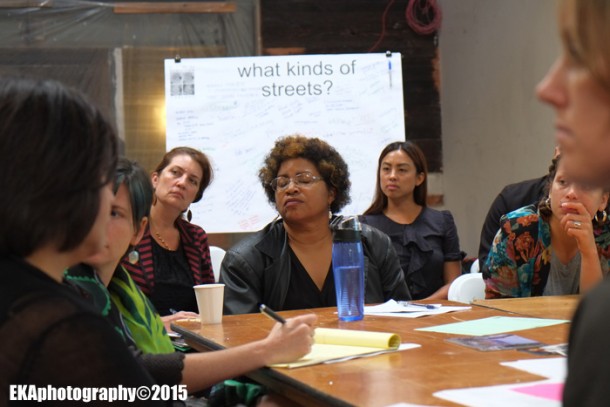
City staffers Kristen Zaremba and Denise Pate at the DOSP meeting held at SPUR’s office
When advocates urged the city to incorporate a cultural equity framework into the planning process, Parker seemed stumped. “What does cultural equity look like?,” she pondered.
Cultural arts staffer Kristen Zaremba said the city was open to conducting a survey to identify artist housing and workspace needs. Yet that seemed an insufficient response to the news that the art galleries on 25th St. – a symbol of Oakland’s cultural renaissance which led directly to the current development boom – were facing imminent displacement.
As Pamela Mays McDonald, an Alameda County Arts Commission and member of the Oakland Art Murmur board said, “They’re using our name to attract developers to destroy us.” City staff did not have an answer for that.
The city employees proposed the idea of a 14th street arts district anchored by the Oakland Museum. “Does that resonate?,” Parker asked. No one jumped at the idea.
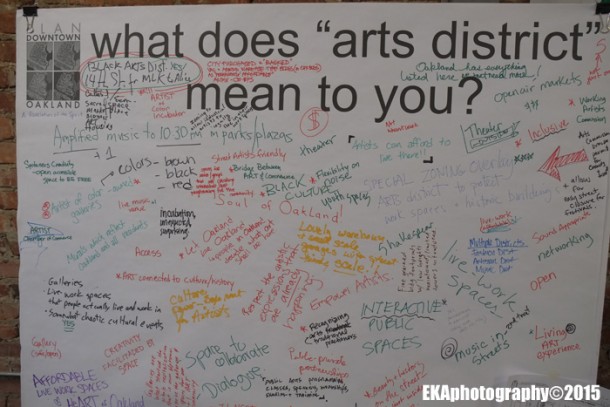
An art district by any other name?
Instead, it was pointed out that the museum is on 10th St., and it perhaps made more sense for an arts district to be anchored by the Joyce Gordon Gallery and the Malonga Casquelord Center, both of which are actually on the 14th St. strip. Author and poet Marvin X passed around a copy of a proposal for a “Black Arts District” honoring the Black Arts Movement, while Judith Smith of AXIS Dance Company noted downtown Oakland used to be a theater district and emphasized the need for a facility which meets the needs of performance groups.
“If city of Oakland doesn’t have the voice of the people, there’s nowhere we can go with this conversation.” — Raw-G
“The city has not kept up Malonga. The Paramount is too big. The Fox is completely unavailable to local artists,” Smith explained. The possibility of retaining the Henry J. Kaiser Auditorium as an arts space was raised, yet that seems like a longshot, since the city recently chose a proposal by Orton Development, rejecting Creative Development Partners, whose proposal would have retained the arena space and added a workforce development program in partnership with Laney College.
City staff also heard an earful from community members. Theater director and playwright Ayodele Nzinga called the DOSP meeting a “blip in a large process that’s already begun,” and questioned the city’s intentionality around arts investment. CRP Executive Director Desi Mundo urged the city to consider youth development in the arts. And bilingual hip-hop artist Raw-G charged, “If city of Oakland doesn’t have the voice of the people, there’s nowhere we can go with this conversation.”
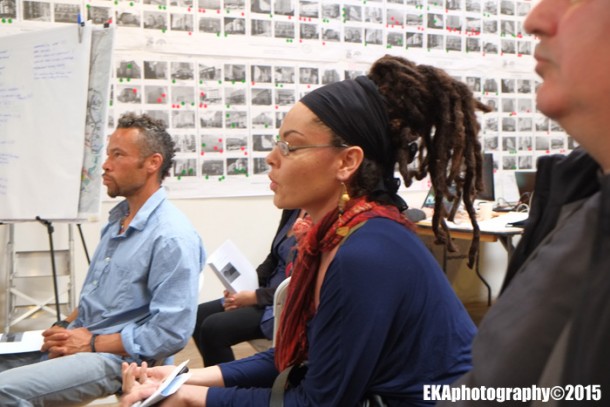
Raw-G prepares to speak her mind
The meeting concluded with many unanswered questions, although Parker insisted, “everyone is welcome to participate” and asked for recommendations from the arts community.
A few days later, a “Techonomic Development forum” held at Impact Hub centered around yet another new downtown development project, the proposed Uptown Station at the site of the former Sears building. The project would reportedly partner with Uber and would be “geared specifically to technology companies.” Developer Alan Dones reiterated a commitment to affordable housing for the massive project combining offices, housing, and retail space, and explained that “techonomic” addressed the impact of displacement, tossing out words like “equity” and “inclusiveness.” Yet, he added, those words apply “if you can raise some capital.”
It’s unclear what role the cultural arts will ultimately play in Uptown Station, which is slated for completion by 2020, though the forum offered some potentially hopeful signs: one small group discussion was devoted entirely to cultural equity, and Dones seemed open to further dialogue with community members.
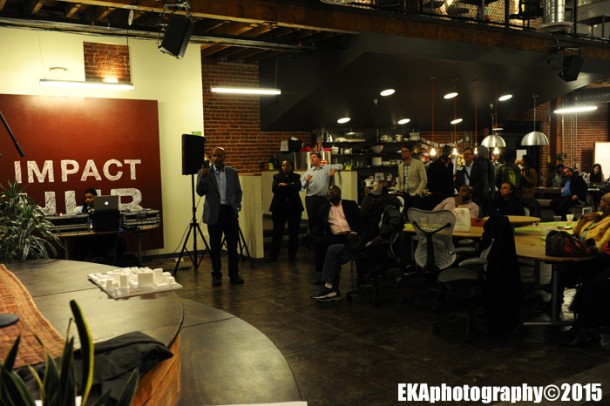
Alan Dones explains “techonomic” at Impact Hub
Yet many obstacles remain to advancing cultural equity, including the lawsuit filed by the Pacific Legal Foundation against Oakland’s percent for art requirement, which would have required new development projects to commit .5% to 1% to public art projects. With the ordinance in legal limbo, current municipal arts investment limited financially, and no comprehensive arts master plan nor consistent policy around mural programs, developers would have to voluntarily invest into community benefits packages which include public art or cultural arts investment – something they’re unlikely to do on their own.
With downtown development ramping up exponentially – the AT&T building at 2150 Webster has been mentioned as “Oakland’s next tech destination” —the focus on tech investment raises critical questions about the neighborhood’s future as an arts district.
Many existing murals are threatened by current development projects, and potential future mural spaces could be eliminated through the construction of ground-level parking structures. As mentioned earlier, an entire block in Uptown currently hosting art galleries is in jeopardy of displacement by Signature Properties (Impact Hub’s landlord). Adding insult to injury, the city’s Planning department has been accused of trying to rush through zoning amendments which favor developers.
City Council President Lynnette Gibson McElhaney recently committed to developing cultural protection legislation and is championing the restoration of the Cultural Arts Commission, but will that go far enough? The same can be said about Mayor Libby Schaff’s Housing Implementation Cabinet, which SPUR says is expected to release an anti-displacement plan in early 2016.
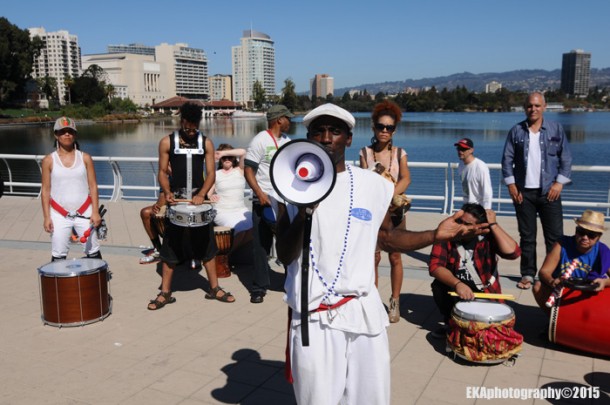
Soul of Oakland’s drum rally helped spur action by elected officials
At present, there appears to be little slowing of the momentum of development, and the Planning department has not had a historically-strong relationship with Oakland’s creative community. Ideally, the Cultural Arts department would already be working on accumulating hard data and evidence of the impact of the cultural economy, not just announcing it was “open” to doing so, as well as working directly with the Planning Department to address displacement of artist spaces while there are still artist spaces in downtown. In reality, the Cultural Arts Dept. is woefully understaffed.
The likelihood of cultural equity being addressed in a meaningful way depends on a sustained level of engagement and activism coming from the community. The city, urban planners and developers have all held public meetings where some concerns have been raised – at least by those who were in the room; the outside pressure from activist groups and resultant media attention has been noted. But merely protesting isn’t enough. Concerns about exclusion and cultural investment have been met with specific requests for input and recommendations around engagement, cultural equity, and specific anti-displacement measures. The message is clear: if the creative arts community doesn’t step up its policy game and develop cultural initiatives to present to the city and planners, it may have no real say in the outcome of what happens around downtown development, and by extension, on whether cultural equity can extend throughout the city’s districts.
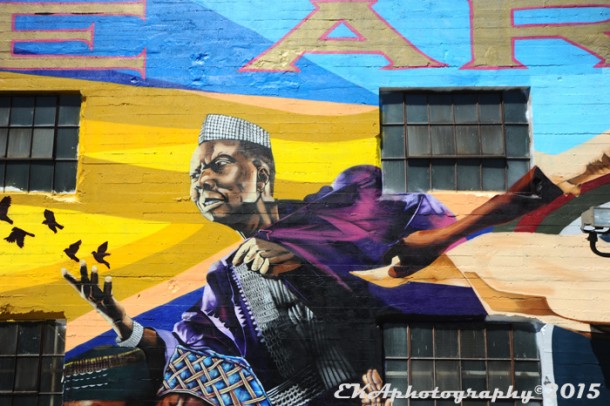
Oakland’s Cultural Heritage is reflected in projects like the Alice St. Mural
For its part, CRP is continuing its mural arts initiative, the Cultural Heritage series represented by the Peace & Dignity and Alice St. Murals; the hope is that similar programs could be enacted throughout the city. But we could do more. The more than 100 murals we’ve painted in Oakland in the last four years each tell a story of community engagement, of violence/blight reduction, of uplifting diverse populations rather than banishing them to Hayward, Antioch and other suburbs. We haven’t yet compiled these stories into case studies. We haven’t yet conducted a survey of muralists and public artists to determine their needs, or make official recommendations based on our history of working in underserved communities as well as with non-profits and neighborhood associations alike. Now seems like as good a time to do so as any.
CRP sees murals as an important part of public art, and we see public art as an important part of cultural arts in general. We’d like to see public art integrated into downtown development, but we’d also like to see a robust, city-wide cultural arts initiative encompassing all artistic disciplines. This means cultural investment in neglected and underdeveloped areas, as well as sustainable economic development initiatives to ensure artists don’t get priced out of areas they helped to cultivate, or displaced entirely due to the influx of tech money and spiraling market-rate rents. We agree artists need access to performance spaces, as well as an official advocate and advisory body at the municipal level. We’d like to see the city make better use of property it owns, whether providing retail storefronts for creative business incubation, or serving as urban canvases for cultural art projects. But most of all, we’d like to see the city’s creative community stay woke, stay engaged, and stay involved.
OCNC General Meeting #5: November 18 (Location TBA)
for more info, visit https://www.facebook.com/KeepOAKCreative

